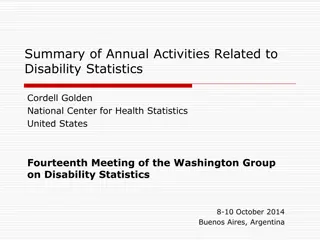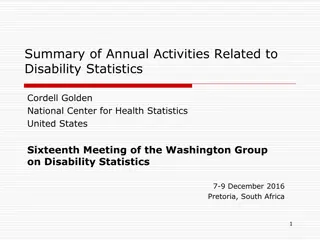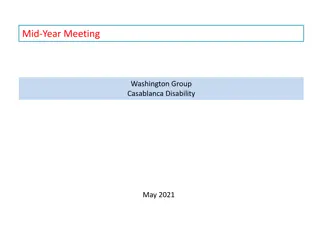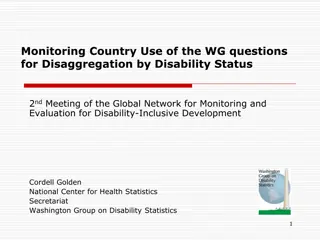Understanding Age Adjustment in Disability Statistics
Explore the significance of age adjustment in disability statistics for creating comparable figures across countries. Learn about crude versus age-adjusted prevalence estimates and the importance of standardized rates for accurate comparisons in different populations. Discover the anatomy of rates, including population rate calculation methods, crude rates, and standardized rates. Uncover why adjusted rates are essential for meaningful comparisons across time, subgroups, and populations, regardless of underlying demographic compositions.
Download Presentation

Please find below an Image/Link to download the presentation.
The content on the website is provided AS IS for your information and personal use only. It may not be sold, licensed, or shared on other websites without obtaining consent from the author. Download presentation by click this link. If you encounter any issues during the download, it is possible that the publisher has removed the file from their server.
E N D
Presentation Transcript
To Age To Age- -Adjust or Not To Age Adjust or Not To Age- -Adjust? Adjust?
Objectives Objectives WG interest in developing a short disability report for use by countries as a way of making comparable disability statistics available Question was raised as to whether the prevalence estimates should be crude or age-adjusted Session is designed to provide background information on age- adjustment for use in determining what should be shown on the reports Proposed outcome: constitution of small group to develop Best Practice recommendations to present at annual meeting or at a special webinar
The Anatomy of a Rate The Anatomy of a Rate Population Rate Calculation 1. Simple method: Rate = number of cases in the population with a characteristic total number of cases 2. More complicated method: Any population can be divided into components (e.g., age groups) Rate = sum of component-specific rates multiplied by a distribution of the population by that component Distribution would come from the data set that the component specific rates come from rate component 1 x proportion of population component 1 rate component 2 x proportion of population component 2 . . rate component n x proportion of the population component n of products = rate . .
The Anatomy of a Rate The Anatomy of a Rate CRUDE RATE sum of the component-specific (e.g., age) rates multiplied by the component (age) distribution of the same population that the component- specific rates come from ADJUSTED or STANDARDIZED RATE sum of the component-specific (e.g., age) rates multiplied by the component (age) distribution of a different population
Why Use an Adjusted or Standardized Why Use an Adjusted or Standardized Rate? Rate? Adjusted rates are NOT real they do not reflect the actual situation in the population -- the crude rates does this; the adjusted rate is a function of the age distribution used Adjusted rates are used for comparisons Across time in the same population (country) for example, trends over the last x years Across different subgroups in the same population for example, males vs females Across populations for example, across countries Adjusted rates are used when The comparisons should not be affected by the underlying composition of population (for example, the age distribution) When a summary indicator is needed rather than looking at the component-specific rates Adjusted rates should not be used if the relationship between the component specific rates varies across population to be compared
When is the Composition of the Population When is the Composition of the Population Not of Interest? Not of Interest? Most demographic and health-related characteristics vary by age so adjustment by age is the most common kind of adjustment Decision to use crude or age-adjusted rates is a function of the intended use of the estimate Example 1: planners need an estimate of the number of people with vision difficulties in urban and rural areas to determine the need for services Example 2: researchers need estimates of vision difficulties in urban and rural areas to see if exposure to area specific irritants is a determinant of vision difficulties
Crude vs Age Crude vs Age- -Adjusted Rates Adjusted Rates Vision difficulties are age-related and the population in rural areas is older Example 1: requires estimates of burden given by a crude rate the fact that the population is older in rural areas would translate into greater burden in that area and the need for more services Example 2: requires estimates of risk given by adjusted rates the hypothesis is that risk of vision difficulties is related to irritants in urban areas but observed higher rates in rural areas could be a function of the age of the population not exposure In this example, the age distribution of the population does not affect the comparison of risk due to exposure and is not of interest age-adjusted rates control for the different age distributions so that differences in risk can be estimated
The Impact of Age Adjustment The Impact of Age Adjustment on Disability Prevalence on Disability Prevalence Examples using data from 3 countries Country A (5 and over and 18 and over), Country B (18 and over), and Country C (5 and over and 18 and over) with different underlying age structures are used for illustrative purposes only; assume data are from the census Step 1: Calculate the crude rates for each country Step 2: Calculate age-specific rates for each country Step 3: Calculate the age-adjusted rates by weighting the age-specific rates for each country using the age distributions from the census for the other countries this gives 4 estimates for 5 and over and 9 estimates for 18 and over Step 4: Compare crude vs adjusted estimates using the different age distributions (standards)
Step 1: Step 1: Calculate the crude disability rates Calculate the crude disability rates (percentages) (percentages) Age Country A Country B Country C 5 years and over 1.8 8.1 18 years and over 2.4 9.1 9.0
Step 2: Step 2: Calculate crude age Calculate crude age- -specific disability rates rates specific disability Age group Country A Country B Country C 5-17 years 0.8 3.7 18-29 years 0.9 2.9 3.7 30-39 years 1.2 3.7 4.0 40-49 years 1.9 6.2 5.4 50-59 years 3.6 13.4 10.2 60-69 years 6.9 16.5 12.3 70-79 years 14.4 31.3 16.5 80+ years 26.8 50.9 33.3
Step 3: Calculate Age Adjusted Step 3: Calculate Age Adjusted rates rates - - Country Age Distributions Country Age Distributions Country A Country B Country C
Step 3: Step 3: Calculate age Calculate age- -adjusted disability rates adjusted disability rates - - population 5 years and over population 5 years and over Country A age-specific disability rate Country A age- specific rate x Country C age- distribution 0.1 0.2 0.2 0.3 0.5 0.9 1.1 1.1 Country C age- specific disability rate Country C age- specific rate x Country A age- distribution 1.4 0.9 0.6 0.6 0.6 0.4 0.3 0.3 5-17 18-29 30-39 40-49 50-59 60-69 70-79 80+ 0.8 0.9 1.2 1.9 3.6 6.9 14.4 26.8 3.8 3.7 4.0 5.4 10.2 12.3 16.5 33.3
Step 3: Step 3: Calculate age Calculate age- -adjusted disability rates adjusted disability rates - - population 18 years and over population 18 years and over Country A age- specific disability rate Country A age-specific estimate x Country B age- distribution Country A age-specific estimate x Country C age- distribution Country B age- specific disability rate Country B age-specific estimate x Country A age- distribution Country B age-specific estimate x Country C age- distribution Country C age- specific disability rate Country C age-specific estimate x Country A age- distribution Country C age-specific estimate x Country B age- distribution 18-29 0.9 0.2 0.2 2.9 1.2 0.6 3.7 1.5 1.0 30-39 1.2 0.3 0.2 3.7 0.9 0.6 4.0 1.0 1.0 40-49 1.9 0.3 0.3 6.2 1.0 1.0 5.4 0.9 0.9 50-59 3.6 0.5 0.6 13.4 1.3 2.2 10.2 1.0 1.5 60-69 6.9 0.7 1.1 16.5 0.8 2.5 12.3 0.6 1.3 70-79 14.4 0.7 1.4 31.3 0.8 2.9 16.5 0.4 0.8 80+ 26.8 0.6 1.3 50.9 0.7 2.5 33.3 0.4 0.7
Step 4: What happens to rates when they are age Step 4: What happens to rates when they are age- - adjusted? adjusted? 5 years and over Crude rate (%) Age-Adjusted Rate using Country C age distribution (%) Age-Adjusted Rate using Country A age distribution (%) Country A Country C 1.8 8.1 4.3 5.1 18 years and over Crude rate (%) Age-Adjusted Rate using Country A age distribution (%) Age-Adjusted Rate using Country B age distribution (%) Age-Adjusted Rate using Country C age distribution (%) Country A Country B Country C 2.4 9.1 9.0 3.4 5.0 12.4 6.7 5.8 7.2
9 8.1 8 Legends Legends 7 6 5.1 Percent 5 4.3 4 3 1.8 2 Each country is assigned a color Country A is blue Country B is orange Country C is green 1 0 Country A Country C Crude disability rate Age-Adjusted rate (using Country C distribution for Country A, and Country A distribution for Country C) Solid colors indicate crude rates (rates calculated using the age distribution of that country) Diagonal lines indicate age-adjustment Outline colors indicate which countries age distribution is used for the age adjustment
Crude Disability Rates Crude Disability Rates 10 9.1 9.0 8.1 8 Percent 6 4 2.4 1.8 2 0 5 years and over 18 years and over Country A Country B Country C
What happens when rates are age adjusted? What happens when rates are age adjusted? 5 years and over 9 8.1 8 7 6 5.1 5 4.3 4 3 1.8 2 1 0 Country A Country C Crude disability rate Age-Adjusted rate (using Country C distribution for Country A, and Country A distribution for Country C)
What happens when rates are age What happens when rates are age- -adjusted? adjusted? 18 years and over 14 12.4 12 10 9.1 9.0 8 7.2 6.7 5.8 6 5.0 3.4 4 2.4 2 0 Country A Country B Country C
Comparisons when based on same age distribution Comparisons when based on same age distribution 5 years and over 5 years and over 5 years and over 10 8.1 8.1 8 6 Percent 5.1 4.3 4 1.8 1.8 2 0 Crude rates Country A age distribution Country C age distribution Country A Country C
Comparisons when based on same age Comparisons when based on same age distribution distribution 18 years and over 18 years and over 18 years and over 14 12.4 12 9.1 9.1 10 9.0 9.0 Percent 7.2 8 6.7 5.8 6 5.0 3.4 4 2.4 2.4 2 0 Crude rates Country A age distribution Country B age distribution Country C age distribution Country A Country B Country C
Impact of Adjustment Impact of Adjustment Three countries have different age distributions Country A has the youngest, followed by Country B. Country C has the oldest age distribution Three countries have different age-specific rates The effect of age adjustment depends on which age distribution is used Using Country A s younger age distribution lowers the rate in Countries B (from 9.1 to 6.7) and C (from 9.0 to 5,8) for the population 18 and over Using Country C s older age distribution raises the rates in Countries A (from 2.4 to 5.0) and B (from 9.1 to 12.4) for the population 18 and over Comparisons across countries will change depending on which age distribution (standard) is used
Next Steps Next Steps Should WG products that include prevalence estimates from more than one country present crude or age-adjusted estimates? Will including both be confusing and take space if multiple prevalences are given (for example, for all domains)? If adjustment is to used, which age composition (standard) should be used? Is there consensus on these topics? The floor is open please raise your hand if you would like to speak or put your comments in the chat Either way we need volunteers for a group to determine Best Practice Recommendations for to address this issue Time limited group Recommendations to be presented at the Fall annual meeting or at a special webinar Any volunteers?

























